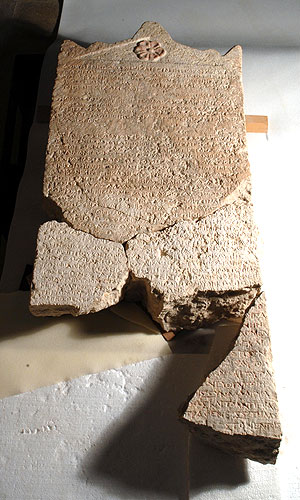An exciting discovery from the excavations of the Antiquities Authority in Beit-Govrin National Park: the discovered inscriptions reveal additional information about the royal inscription that was displayed in the Israel Museum * The revealed information links the inscription to the Maccabean Revolt

A royal inscription from 178 BC, containing 23 lines inscribed in Greek on a stone tablet - and known as the "Heliodorus Inscription" - was exhibited at the Israel Museum for the first time two years ago, on long-term loan from Michael and Judy Steinhardt, New York. The inscription is considered one of the most important ancient inscriptions discovered in the Land of Israel, even though the stone tablet and the entire inscription were not complete. To this day.
Recently, three fragments of a Greek inscription were discovered in the excavations of the Antiquities Authority at Tel Marsha in Beit Govrin National Park, under the supervision of Dr. Ian Stern and Bernie Alpert. They were discovered in an underground complex, by the participants in the program of Archaeological Seminars, "Dig for a Day". Dr. Dov Gra, who studied the inscriptions presented to him by Dr. Stern, recently determined that the fragments actually formed the lower part of the "Heliodorus inscription" in the Israel Museum. The discovery confirmed the hypothesis that the origin of the inscription is in the ancient city of Marsha, which is now within the boundaries of the Beit Govrin National Park.
As published by Professors Cotton-Flatiel and Worla in 2007, the entire inscription is a proclamation of King Seleucus IV, the father of Antiochus IV, regarding the appointment of "in charge of the temples" in our region, in 178 BC. The king announces the appointment of his deputy - Heliodorus. This is probably the same person mentioned in Maccabi XNUMX:XNUMX, where it is said that he tried to steal the funds of the temple in Jerusalem, but instead was severely beaten as a result of divine intervention. Three years later Seleucus was assassinated and his son Antiochus succeeded him. This is the ruler who, according to the Book of Maccabim, persecuted the Jews and was inspired by him to desecrate the Temple, which led to the Maccabian Rebellion.
"It can be determined that the stone tombstone originates from the city of Marsha and it adds important archaeological and historical evidence and context to the understanding of the period of time up to the Maccabean Revolt, an event that is publicized every year during the Hanukkah holiday, adds Dr. Ian Stern, Director of Excavations on behalf of the Antiquities Authority. "This is the result of the joint work of an institution" "Archaeological seminars" and the "Dig for a Day" program, the Antiquities Authority and the Nature and Parks Authority personnel in the Beit Govrin National Park."

One response
This is a really interesting and important discovery